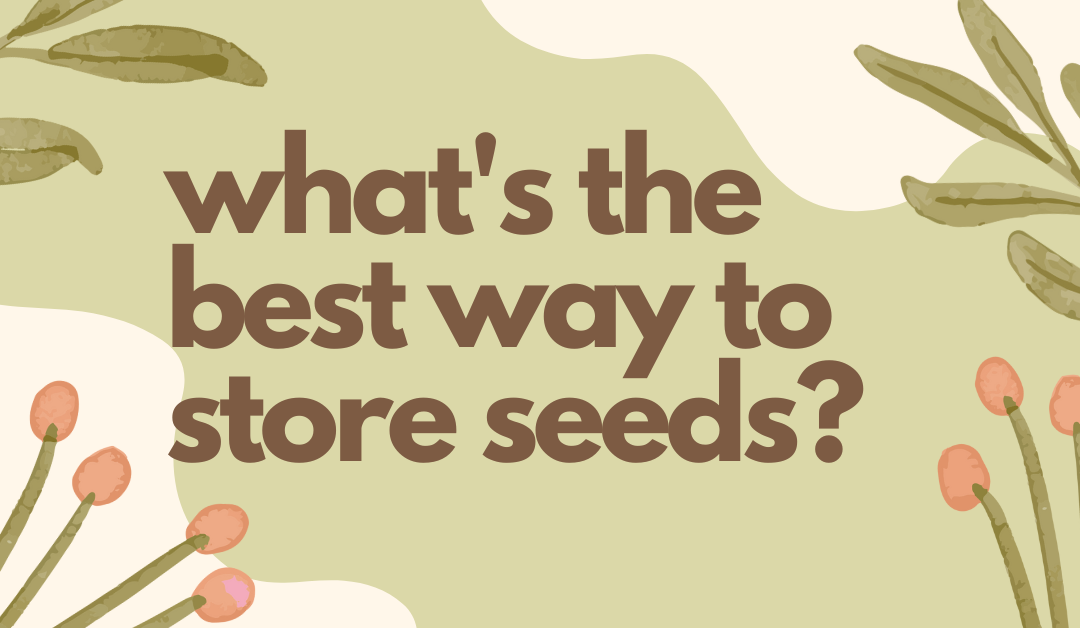Whether you’re saving your own seeds or buying them from a trusted supplier, it’s important to ensure that you’re storing them properly. Proper storage will help preserve seed quality and viability. But what is the best way to store seeds? How long do seeds last? Here’s what you need to know about seed storage.
Best Way to Store Seeds for Long Term Storage and Next Year’s Planting
Whether you only need to store your seeds for next year or the long term, creating the right environment for your seeds is crucial.
Let’s look at the best conditions for seed storage and how to prevent disease.
The Best Conditions for Storing Seeds
Seeds are best stored in:
- Cool temperatures
- Airtight containers
- Dry, dark places
A cool, dry basement is ideal for seed storage because it typically has consistent temperatures below 60℉.
It may seem convenient to toss your seeds in the garage or garden shed, but outdoor temperature fluctuations can make them unviable. Keep your seeds away from heat and out of the sun.
Start with Completely Dry Seeds
You can have the best conditions for seed storage, but if your seeds aren’t completely dry before you store them, there’s a good chance that they’ll spoil. Always make sure that any excess moisture is removed before you tuck your seeds away for future planting.
Check out our guide on How to Dry Seeds to make sure yours are ready for storage.
Temperature & Light Conditions
You know that a “cool, dark” place is ideal for seed storage, but what exactly does that mean?
- According to the USDA, the ideal storage temperature for seeds is below 50℉.
- Dim or no light is ideal for storing your seeds.
Many household basements meet these conditions, but it’s important to make sure that the space is dry. Ideally, the humidity levels should be below 50%.
How To Store Seeds Long Term – Storing Seeds in the Freezer
The freezer is the next best thing if you don’t have a basement or other location that’s cold or dry enough for seed storage.
The refrigerator is another option, but the temperature fluctuates each time you open and close the door. Unfortunately, those fluctuations aren’t ideal for your seeds.
The freezer is one of the best options for seed storage because it will provide the most consistent temperature for your seeds. But before you toss your seed packet in the freezer, there are a few important things to do:
- Make sure your seeds are completely dry. Toss a silica gel packet in with your seeds for a few days to remove all excess moisture.
- Keep your seeds in airtight containers. If you’re not storing your seeds in an airtight container, then you may introduce moisture that can spoil your seeds.
If you store your seeds in the freezer, you’ll need to take a few extra steps to prepare them for planting.
- Remove the seeds from the freezer and let them rest for 12 hours.
- Do not open the container until after the seeds have rested and come to room temperature.
Preventing Disease
Pests are always a concern when storing seeds. If you’re keeping your seeds in the freezer, you don’t have much to worry about here. However, if you’re storing them in a basement or closet, then there’s a risk of pests and disease.
Here are a few tips:
- Toss your seeds in the freezer for a few days to kill insect larvae.
- Use an airtight container. Pests need oxygen, and an airtight container will rob them of it.
- Use containers made of heavy-duty plastic, glass jars or metal to keep rodents away.
How Long Do Seeds Last in Storage?
With the right storage conditions, many seeds can remain viable for more than one year. Those stored in the freezer can last two to five years in some cases.
Short-lived seeds are best replaced every year. These include:
- Parsley
- Asters
- Leeks
- Delphinium
- Onions
- Phlox
- Parsnip
On the other hand, some herb and vegetable seeds have quite a long life span, including:
- Basil (up to 5 years)
- Brussels sprouts (up to 3 years)
- Cucumbers (up to 5 years)
- Beets (up to 4 years)
- Cabbage (up to 3 years)
- Chard (up to 4 years)
- Pumpkin (up to 4 years)
- Kale (up to 4 years)
- Tomatoes (up to 4 years)
- Squash (up to 4 years)
- Beans and peas (up to 3 years)
With the right storage conditions and the right seeds, you can have seeds ready for planting for the next few years.
Expect A Few Duds
Even with optimal storage conditions, some of your seeds won’t be viable. Expect there to be a few duds. Even freshly harvested seeds are sometimes not viable.
Toss Any Seeds Past Their Prime
The quality of seeds declines over time, and eventually, some unused seeds won’t be viable. When storing your seeds, make sure that you write down the date of storage and the expiration date on the seed packet (if you bought your seeds).
If you have seeds that are past their prime, toss them or compost them.
What Causes Seed Degradation?
Seeds degrade naturally over time, but there are some factors that can speed up the deterioration, including:
- High temperatures
- High relative humidity
If seeds are stored in a warm, humid place, they attempt to come out of dormancy. Warmth and moisture can also promote bacterial growth and attract pests that can ruin the seeds.
Using the right seed storage box or container in the right environment can help prevent degradation.
Seed Storage Containers and Organization
There are so many seed storage ideas out there. The right one for you will depend on the volume of seeds you need to store and where you plan to store them.
Here are some of the most common containers used for seed storage:
- Paper Envelopes
- Photo albums
- Mason jars
- Metal boxes
Organizing Seeds
No matter which type of storage container you use, it’s important to keep your seeds organized. One simple way to do that is to keep your seeds inside the seed packets they came in and place them inside of a larger container.
You can also organize your seeds by:
- Planting dates (spring, fall, etc.)
- Plant types
Use rubber bands to keep similar seeds together. For example, if you have multiple varieties of kale, a rubber band is a simple way to keep these varieties together and easily accessible.
Seed storage doesn’t have to be complicated, but a little planning and preparation can go a long way in making your seeds last as long as possible.
Rene is a creative, little gnome. When she’s not diving deep into research on health and wellness, she’s spending here time out in nature, growing her homestead, photographing wildlife, doing yoga or enjoying a zen (depending on the day) moment with her fur babies. And on top of all of that, she’s a professional writer by day, helping businesses around the world grow.

